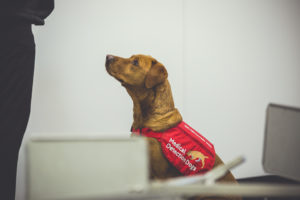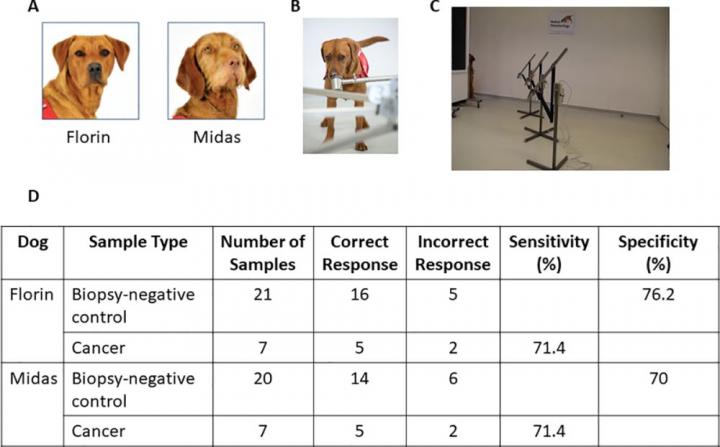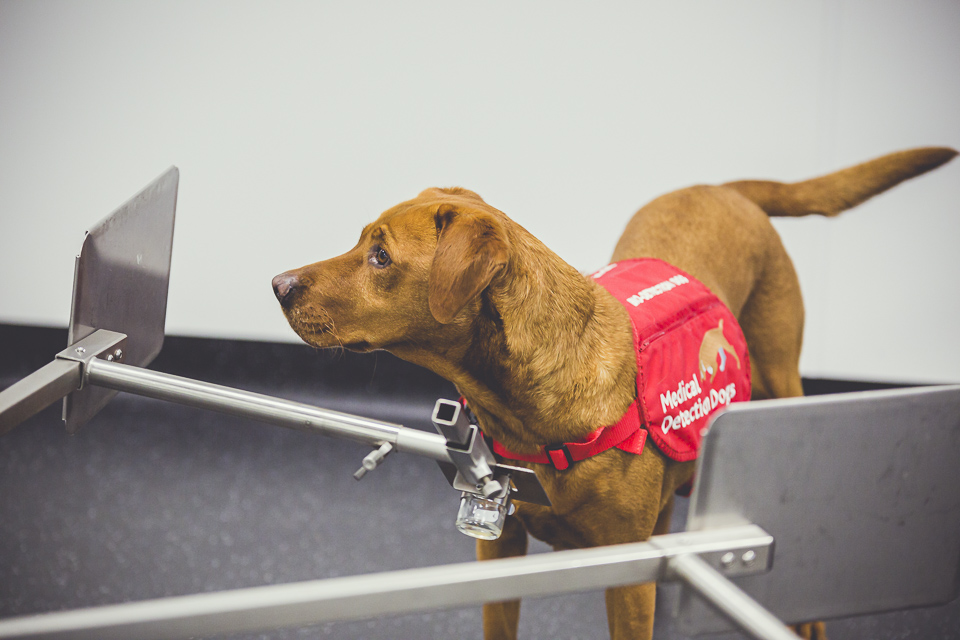Research by an international team of investigators has demonstrated the ability of trained dogs to detect aggressive prostate cancer from urine samples, and suggests that an artificial neural network could learn from this olfactory capability. The scientists say findings from the study, which is reported in PLOS One, could feasibly be used to help direct the development of novel, machine-based tools for detecting prostate cancer, which integrate canine olfaction with the analysis of volatile organic compounds (VOCs) in urine, microbial profiling, and artificial neural network (ANN)-assisted examination. Study lead Claire Guest, from Medical Detection Dogs, in the U.K., and colleagues in the U.K. and U.S., claimed, “We’ve shown it is possible to replicate the dog’s performance as sensors and brains, it is now time to put this technology in every smartphone.”
The researchers report their results in a paper titled, “Feasibility of integrating canine olfaction with chemical and microbial profiling of urine to detect lethal prostate cancer,” in which they concluded, “This study demonstrated feasibility and identified the challenges of a multiparametric approach as a first step towards creating a more effective, non-invasive early urine diagnostic method for the highly aggressive histology of prostate cancer.”
Prostate cancer is the second leading cause of cancer death in men in the developed world, and in the U.K. prostate cancer has overtaken breast cancer in terms of total deaths caused, the authors wrote. “Approximately 1 in 9 men will be diagnosed with prostate cancer at some point in their lives.” Early biomarker detection of prostate cancer has been “controversial,” they continued, as the widely used prostate specific antigen (PSA) screening test can miss aggressive prostate cancer in men who have it, or indicate that a cancer is aggressive when it really poses little risk. PSA testing may also erroneously detect benign conditions such as benign prostatic hyperplasia (BPH) and prostatitis.
A more sensitive and specific strategy for detecting the disease, beyond PSA screening, is thus urgently needed, the authors wrote. “In particular, what is needed is a prostate cancer diagnostic tool to allow differentiation of potentially lethal, high Gleason Grade cancers with metastatic potential from indolent, low-grade cancers that patients would die with and not from.”
Alternative tests are being explored, and research has shown that dogs can be trained to detect prostate cancer from urine samples with a high degree of accuracy. “One potential method towards improved prostate cancer diagnosis that has been receiving increased attention is trained canine olfaction,” Guest and colleagues explained. “Over the past three decades, trained dogs have been shown to be capable of detecting various human diseases including many types of cancer by scent.”

However, given the limited numbers of trained canines, using dogs to detect prostate cancer would be impractical for large-scale screening. For their pilot study, Guest and colleagues set out to determine what it is that the dogs are detecting, and to combine the strengths of canine olfaction with other promising detection methods, such as the detection of volatile organic compounds in urine, and analysis of the urinary microbiome.
Given the limitations of current diagnostic methods, and of existing methods for molecular VOC analysis by gas chromatography-mass spectroscopy (GC-MS), the team reasoned that integrating multiple existing approaches might lead to better diagnosis, provide new insights into the underlying disease pathology, and point to a way of developing machine olfaction-based urinary screening and diagnosis. “Rather than rely solely on one method (canine detection, volatilomics, urinary microbiota profiling) to improve diagnostic efficacy, in this pilot study, we sought to combine the strengths of each to create new insight into how further integrative diagnostic developments can be made,” they wrote.
To do this, the team simultaneously submitted urine samples of patients either with or without biopsy-proven prostate cancer, for detection by trained canine olfaction, identification of VOCs using GC-MS analysis, and microbiota profiling.
The researchers trained two dogs to detect aggressive prostate cancer from the urine samples. These dogs showed 71% sensitivity (ability to identify truly positive cases) and 70–76% specificity (ability to correctly identify negative cases) in detecting prostate cancer with a Gleason score of 9, indicating highly aggressive disease.

The team also applied gas chromatography-mass spectroscopy analysis of volatile compounds in urine, and analysis of microbial species found naturally in urine. Both these methods were also able to highlight key differences between cancer-positive and cancer-negative samples. “To our knowledge, this is the first study to profile both urinary VOCs and urinary microbial populations in the same urine samples,” they pointed out. Canine olfaction was able to discriminate between prostate cancer and biopsy-negative urine samples, and the VOC and microbiota profiling analyses showed a qualitative difference between the two groups.
The researchers then used the dogs’ data to train an artificial neural network to identify specific portions of the spectroscopy data that contributed significantly to the dogs’ diagnoses. This also revealed specific differences between positive and negative samples. And while the reported study involved only a small number of samples, its hoped that larger studies could further integrate these different methodologies with a view to improving the detection of advanced prostate cancer and aiding the development of new diagnostic tools that replicate dogs’ olfactory capabilities. “Our results demonstrate the canine ability to discriminate, learn, and improve detection even when presented a small number of samples of a complex odor. The challenge remains on how to port canine intelligence into machine olfactors.”

They concluded that the results indicate the feasibility of discriminating Gleason 9 prostate cancer from biopsy-negative controls, using integrative analysis of very different methodologies—trained canine olfaction, conventional GC-MS analysis of urine VOC, urinary microbiota profiling on the same samples, and their novel, purpose-developed ANN approach—each of which has been shown capable to various degrees by itself. “This study demonstrated feasibility and identified the challenges of a multiparametric approach as a first step towards creating a more effective, non-invasive early urine diagnostic method for the highly aggressive histology of prostate cancer … Although tested on a small sample set which does not enable us to make definitive conclusions about accuracy, the results achieved in this pilot support the potential of specialist trained detection dogs directly assisting in the development of an ANN to run on a bio-electronic machine olfaction diagnostic device.”






